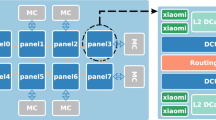Abstract
The proliferation of modern computer architectures brings a great challenge to sparse matrix-vector multiplication (SpMV), which is widely used in scientific computing and artificial intelligence. Providing a suitable sparse matrix format for SpMV is crucial to achieve high performance by enhance data locality and cache performance. However, for different architectures, the best sparse matrix format varies. In this paper, we propose a novel architecture adaptive sparse matrix format selection method, MANet, to select proper format to optimize performance of SpMV. This method transforms a sparse matrix into a high-dimensional image, with the matrix sparseness feature and architecture feature combined as inputs. To evaluate the effectiveness of this method, we generated a dataset that includes various scientific problems and architectures with augmentation. Results show that MANet improves sparse matrix selection accuracy by 6% compared to previous works and can achieve a speedup of up to 230% compared to methods with a fixed format. When adapting to an architecture that is not presented in the training, it can still provide 88% selection accuracy and 14% higher than the previous approaches, without further training.
Access this chapter
Tax calculation will be finalised at checkout
Purchases are for personal use only
Similar content being viewed by others
References
Mbw: Memory bandwidth benchmark (2010). http://manpages.ubuntu.com/manpages/lucid/man1/mbw.1.html
Chen, D., Fang, J., Chen, S., Xu, C., Wang, Z.: Optimizing sparse matrix-vector multiplications on an armv8-based many-core architecture. Int. J. Parallel Prog. 47(3), 418–432 (2019). https://doi.org/10.1007/s10766-018-00625-8
Chen, T., et al.: Xgboost: extreme gradient boosting. R package version 0.4-2 1(4), 1–4 (2015)
Davis, T.A., Hu, Y.: The university of florida sparse matrix collection. ACM Trans. Math. Softw. 38(1), 1–25 (2011)
Grossman, M., Thiele, C., Araya-Polo, M., Frank, F., Alpak, F.O., Sarkar, V.: A survey of sparse matrix-vector multiplication performance on large matrices. arXiv preprint arXiv:1608.00636 (2016)
Langr, D., Tvrdik, P.: Evaluation criteria for sparse matrix storage formats. IEEE Trans. Parall. Distrib. Syst.27(2), 428–440 (2016). https://doi.org/10.1109/tpds.2015.2401575, https://ieeexplore.ieee.org/document/7036061/
Li, M.L., Chen, S., Chen, J.: Adaptive learning: a new decentralized reinforcement learning approach for cooperative multiagent systems. IEEE Access 8, 99404–99421 (2020). https://doi.org/10.1109/ACCESS.2020.2997899
Muhammed, T., Mehmood, R., Albeshri, A., Katib, I.: Suraa: A novel method and tool for loadbalanced and coalesced spmv computations on gpus. Appl. Sci. 9(5), 947 (2019)
Nisa, I., Siegel, C., Rajam, A.S., Vishnu, A., Sadayappan, P.: Effective machine learning based format selection and performance modeling for spmv on gpus. In: 2018 IEEE International Parallel and Distributed Processing Symposium Workshops (IPDPSW). IEEE. https://doi.org/10.1109/ipdpsw.2018.00164, https://ieeexplore.ieee.org/document/8425531/
Oyarzun, G., Peyrolon, D., Alvarez, C., Martorell, X.: An fpga cached sparse matrix vector product (spmv) for unstructured computational fluid dynamics simulations. arXiv preprint arXiv:2107.12371 (2021)
Paszke, A., et al.: Pytorch: An imperative style, high-performance deep learning library. In: Advances in NeurIPS 32, pp. 8024–8035 (2019). http://papers.neurips.cc/paper/9015-pytorch-an-imperative-style-high-performance-deep-learning-library.pdf
Pichel, J.C., Pateiro-Lopez, B.: A new approach for sparse matrix classification based on deep learning techniques. In: 2018 IEEE International Conference on Cluster Computing (CLUSTER). IEEE. https://doi.org/10.1109/cluster.2018.00017, https://ieeexplore.ieee.org/document/8514858/
Pichel, J.C., Pateiro-Lopez, B.: Sparse matrix classification on imbalanced datasets using convolutional neural networks. IEEE Access 7, 82377–82389 (2019). https://doi.org/10.1109/access.2019.2924060, https://ieeexplore.ieee.org/document/8742660/
Qiu, S., You, L., Wang, Z.: Optimizing sparse matrix multiplications for graph neural networks. In: Li, X., Chandrasekaran, S. (eds.) Languages and Compilers for Parallel Computing: 34th International Workshop, LCPC 2021, Newark, DE, USA, October 13–14, 2021, Revised Selected Papers, pp. 101–117. Springer International Publishing, Cham (2022). https://doi.org/10.1007/978-3-030-99372-6_7
Sun, X., Zhang, Y., Wang, T., Zhang, X., Yuan, L., Rao, L.: Optimizing spmv for diagonal sparse matrices on gpu. In: 2011 International Conference on Parallel Processing, pp. 492–501 (2011). https://doi.org/10.1109/ICPP.2011.53
Terpstra, D., Jagode, H., You, H., Dongarra, J.: Collecting performance data with PAPI-C. In: Müller, M.S., Resch, M.M., Schulz, A., Nagel, W.E. (eds.) Tools for High Performance Computing 2009: Proceedings of the 3rd International Workshop on Parallel Tools for High Performance Computing, September 2009, ZIH, Dresden, pp. 157–173. Springer Berlin Heidelberg, Berlin, Heidelberg (2010). https://doi.org/10.1007/978-3-642-11261-4_11
Virtanen, P., et al.: SciPy 1.0 Contributors: SciPy 1.0: fundamental algorithms for scientific computing in Python. Nature Methods 17, 261–272 (2020). https://doi.org/10.1038/s41592-019-0686-2
Vuduc, R., Demmel, J.W., Yelick, K.A.: Oski: A library of automatically tuned sparse matrix kernels. In: Journal of Physics: Conference Series. vol. 16, p. 071 (2005)
Zhao, Y., Li, J., Liao, C., Shen, X.: Bridging the gap between deep learning and sparse matrix format selection. In: Proceedings of the 23rd ACM SIGPLAN Symposium on Principles and Practice of Parallel Programming. ACM. https://doi.org/10.1145/3178487.3178495, https://dl.acm.org/doi/pdf/10.1145/3178487.3178495
Acknowledgements
We express our thanks to the anonymous reviewers for their insightful comments that improved the quality of the manuscript and Suit Sparse Matrix Collection for the dataset.
Author information
Authors and Affiliations
Corresponding author
Editor information
Editors and Affiliations
Rights and permissions
Copyright information
© 2024 The Author(s), under exclusive license to Springer Nature Singapore Pte Ltd.
About this paper
Cite this paper
Sun, Z., Qiao, P., Dou, Y. (2024). MANet: An Architecture Adaptive Method for Sparse Matrix Format Selection. In: Tari, Z., Li, K., Wu, H. (eds) Algorithms and Architectures for Parallel Processing. ICA3PP 2023. Lecture Notes in Computer Science, vol 14488. Springer, Singapore. https://doi.org/10.1007/978-981-97-0801-7_18
Download citation
DOI: https://doi.org/10.1007/978-981-97-0801-7_18
Published:
Publisher Name: Springer, Singapore
Print ISBN: 978-981-97-0800-0
Online ISBN: 978-981-97-0801-7
eBook Packages: Computer ScienceComputer Science (R0)




